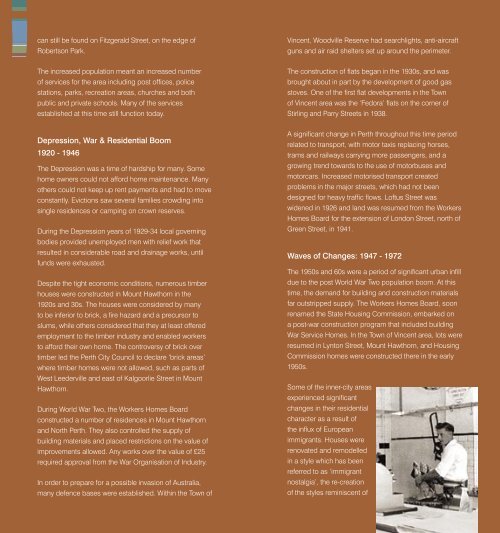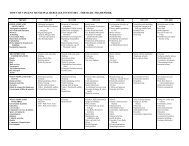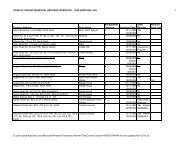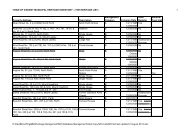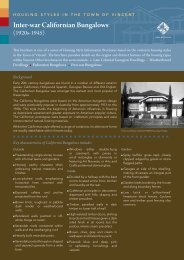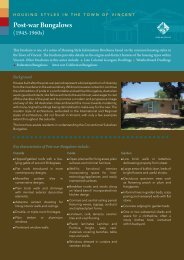our heritage - Vincent Heritage
our heritage - Vincent Heritage
our heritage - Vincent Heritage
- No tags were found...
You also want an ePaper? Increase the reach of your titles
YUMPU automatically turns print PDFs into web optimized ePapers that Google loves.
can still be found on Fitzgerald Street, on the edge ofRobertson Park.<strong>Vincent</strong>, Woodville Reserve had searchlights, anti-aircraftguns and air raid shelters set up around the perimeter.The increased population meant an increased numberof services for the area including post offices, policestations, parks, recreation areas, churches and bothpublic and private schools. Many of the servicesestablished at this time still function today.The construction of flats began in the 1930s, and wasbrought about in part by the development of good gasstoves. One of the first flat developments in the Townof <strong>Vincent</strong> area was the ‘Fedora’ flats on the corner ofStirling and Parry Streets in 1938.Depression, War & Residential Boom1920 - 1946The Depression was a time of hardship for many. Somehome owners could not afford home maintenance. Manyothers could not keep up rent payments and had to moveconstantly. Evictions saw several families crowding intosingle residences or camping on crown reserves.During the Depression years of 1929-34 local governingbodies provided unemployed men with relief work thatresulted in considerable road and drainage works, untilfunds were exhausted.Despite the tight economic conditions, numerous timberhouses were constructed in Mount Hawthorn in the1920s and 30s. The houses were considered by manyto be inferior to brick, a fire hazard and a precursor toslums, while others considered that they at least offeredemployment to the timber industry and enabled workersto afford their own home. The controversy of brick overtimber led the Perth City Council to declare ‘brick areas’where timber homes were not allowed, such as parts ofWest Leederville and east of Kalgoorlie Street in MountHawthorn.During World War Two, the Workers Homes Boardconstructed a number of residences in Mount Hawthornand North Perth. They also controlled the supply ofbuilding materials and placed restrictions on the value ofimprovements allowed. Any works over the value of £25required approval from the War Organisation of Industry.In order to prepare for a possible invasion of Australia,many defence bases were established. Within the Town ofA significant change in Perth throughout this time periodrelated to transport, with motor taxis replacing horses,trams and railways carrying more passengers, and agrowing trend towards to the use of motorbuses andmotorcars. Increased motorised transport createdproblems in the major streets, which had not beendesigned for heavy traffic flows. Loftus Street waswidened in 1926 and land was resumed from the WorkersHomes Board for the extension of London Street, north ofGreen Street, in 1941.Waves of Changes: 1947 - 1972The 1950s and 60s were a period of significant urban infilldue to the post World War Two population boom. At thistime, the demand for building and construction materialsfar outstripped supply. The Workers Homes Board, soonrenamed the State Housing Commission, embarked ona post-war construction program that included buildingWar Service Homes. In the Town of <strong>Vincent</strong> area, lots wereresumed in Lynton Street, Mount Hawthorn, and HousingCommission homes were constructed there in the early1950s.Some of the inner-city areasexperienced significantchanges in their residentialcharacter as a result ofthe influx of Europeanimmigrants. Houses wererenovated and remodelledin a style which has beenreferred to as ‘immigrantnostalgia’, the re-creationof the styles reminiscent of


